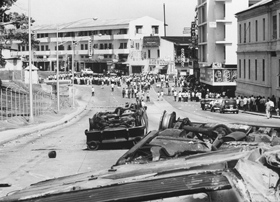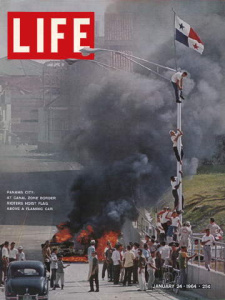Why Today Is an Anti-American Holiday in Panama

Few Americans know that January 9 is a national holiday in Panama, and even fewer know why. Today is Martyrs’ Day—commemorating an outbreak of violence between Panama and the United States in 1964. The confrontation left four Americans and twenty-two Panamanians dead, and it deeply strained U.S.-Panama relations. It marked the beginning of a process that would induce the United States to relinquish its rights to the Panama Canal in the decade that followed. And “it all began,” as LIFE magazine reported, “because there was one vacant flagpole at Balboa High School.”
The history of U.S. involvement in Panama goes back to the 1850s, when Americans heading for the California gold fields trekked across the isthmus. Soon New York investors were building a lucrative railroad to accommodate the travelers. A riot in 1856 signaled local resentment of the North Americans’ encroachment.
In 1880 President Rutherford Hayes declared his country’s intention to build “a canal under American control.” The United States intervened militarily in Panama a dozen times during the second half of the nineteenth century, all leading up to President Theodore Roosevelt’s support for an uprising that gave Panama independence from Colombia in 1903. The Americans then used their leverage to conclude a treaty that gave the United States control of the ten-mile-wide Canal Zone in perpetuity and the right to intrude militarily in Panamanian affairs.
Sovereignty over the Zone remained a bone of contention after the United States finished building the canal, in 1914. Protests in 1955 prompted President Dwight Eisenhower to make minor concessions to the Panamanians, but he would not relinquish the perpetuity provision of the original treaty. After more demonstrations in the late 1950s, the United States allowed the Panamanians to fly their flag at one location in the Zone. President Kennedy, eager to improve U.S. relations with Latin America, agreed to talk about the issues of dispute between the countries.

Any hint of concession worried the ultrapatriotic U.S. citizens who lived and worked in the Zone. Kennedy’s declaration that the U.S. and Panamanian flags should be flown together at all nonmilitary sites prompted Zonian students, with the encouragement of adults, to raise the Stars and Stripes alone outside Balboa High School on January 7, 1964. The teenagers guarded the flag for two days before a group of 200 Panamanian students marched from nearby Panama City intent on raising their own banner. During the ensuing scuffle, the Panamanian flag was torn.
Thousands of angry Panamanian citizens took to the streets, forced their way into the Zone, and attacked American-owned businesses. The Canal Zone police were overwhelmed, and the U.S. Army took over, responding to the violence with tear gas and rifle fire. Ascanio Arosemena, a 20-year-old student on his way to movie, stopped to helped to evacuate some of the wounded. He was shot dead.
Demonstrators attacked the “fence of shame” that divided the Canal Zone from the rest of Panama. The Colombia ambassador to the Organization of American States pointed to the barrier and declared, “In Panama there exists today another Berlin Wall.”
Panama broke diplomatic relations with the United States on January 10. Some Panamanians demanded that the U.S. hand over the Canal Zone immediately. Sporadic shooting came from both sides of the border. American soldiers trying to eliminate a sniper in an apartment building instead shot and killed Rosa Elena Landecho, an 11-year-old girl.

With the Panamanian National Guard unwilling to intervene, the fighting went on for another four days. Rioters sacked some Panamanian as well as American businesses. The new United States Information Services library, part of the Kennedy administration’s effort to win the propaganda war in Latin America, went up in flames. American embassy personnel destroyed sensitive documents and fled, though the embassy was not invaded.
Life blamed the events on ”patriotic but misguided Americans who did not realize that they were away from home.” President Lyndon Johnson, facing his first foreign-policy crisis and realizing that the Panamanians would use the violence to pressure him for concessions, warned them not “to try to exact a new treaty from me by force.”
The riots caused $2 million in damage before the National Guard stepped in to quell the violence on January 14. The incident focused world attention on U.S. policies in Latin America and on the lopsided 1903 treaty in particular. “The plain fact is that we must begin treating Panamanians as people,” said the Canal Zone’s governor, Robert J. Fleming.
Panamanian president Roberto Chiari restored diplomatic relations in April. After his election later in 1964, President Johnson agreed to talk about “an entirely new treaty” to delineate U.S. rights in the country. After three years of negotiations, a new pact was concluded that would eliminate the perpetuity clause, but opposition inside both countries kept it from being enacted.
By the 1970s America’s two-ocean navy and long-range bombers and missiles had obviated much of the strategic military importance of the canal. Talks on a treaty to return the zone to Panama began early in the decade and were concluded under President Jimmy Carter in 1978. Congress reluctantly went along.
Operation of the canal was gradually passed to the Panamanians.
